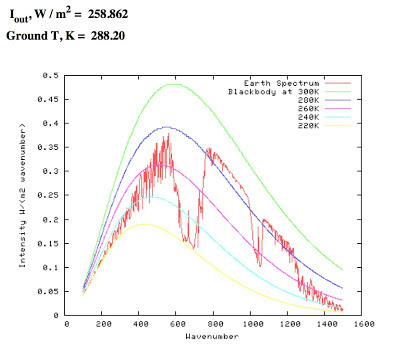We see in the lower plot that water vapor H2O is concentrated to the lower troposphere, while CO2 is spread out through the whole atmosphere.
The OLR spectrum in red shows the effect of water vapor as emission in the lower troposphere at a temperature of about 250 K for wave numbers smaller than 550, and the effect of CO2 as emission in the upper troposphere at a temperature of about 220 K for wave numbers in the range 550 - 800.
What determines the effective emission temperature/altitude and thus the OLR spectrum, is the transparency of the atmosphere above the effective emission altitude. If CO2 was concentrated to the lower troposphere the effective emission temperature in the band 550 - 800 would be higher with an increase of OLR and thus a smaller warming effect from CO2.
The key question of the effect of increasing CO2 to 600 ppm from the present 390 ppm, is thus the effect on the transparency of the atmosphere in the band 550 - 800 in the upper troposphere and tropopause. Modtran shows this effect to be
We see a warming of 2 W/m2 as an effect of a slightly wider/deeper ditch for wave numbers 550 - 800 including the main resonance of CO2 at 667.
We observe that the 2 W/m2 is about half of the basic postulate of CO2 alarmism of 3.7 W/m2 upon doubling from 300 ppm, and that these 2 W/m2 come out from a very subtle change of transparency with small broadening of the ditch in the CO2 spectrum for emission at 240 - 250 K, on the "shoulders" of the CO2 spectrum around 667. Experimental support of this effect is missing, and the effect may just be an artifact of an ad hoc assumption in Modtran with emissivity simply scaling with path length.
Summary:
- The effect of H2O as greenhouse gas GHG is seen in the OLR spectrum as a substantial decrease of effective emission temperature in the lower troposphere for wave numbers smaller than 550.
- The 2 W/m2 of "radiative forcing" from doubled CO2 is the result of a subtle effect of line broadening on the shoulders around 667 at low pressure and long path length. The warming effect of 2 W/m2 is commonly translated to a global warming of 0.5 C, which is to small to be observed.
- Modtran shows a substantial effect of water vapor and a negligible effect of CO2.
- Modtran is presented as the main evidence of a possibly alarming global warming from doubled CO2, but if anything Modtran shows that the effect is too small to be observed and thus cannot be alarming.







Inga kommentarer:
Skicka en kommentar